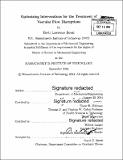| dc.contributor.advisor | Elazer R. Edelman. | en_US |
| dc.contributor.author | Boval, Brett Lawrence | en_US |
| dc.contributor.other | Massachusetts Institute of Technology. Department of Mechanical Engineering. | en_US |
| dc.date.accessioned | 2015-02-05T18:30:18Z | |
| dc.date.available | 2015-02-05T18:30:18Z | |
| dc.date.copyright | 2014 | en_US |
| dc.date.issued | 2014 | en_US |
| dc.identifier.uri | http://hdl.handle.net/1721.1/93858 | |
| dc.description | Thesis: S.M., Massachusetts Institute of Technology, Department of Mechanical Engineering, 2014. | en_US |
| dc.description | Cataloged from PDF version of thesis. | en_US |
| dc.description | Includes bibliographical references (pages 85-94). | en_US |
| dc.description.abstract | All tissues rely on perfusion and therefore intact blood flow. When flow is disrupted the coupled interaction between the functional and fluid domains of a tissue is impeded and viability is lost. Aortic stenosis is a paradigmatic example of vascular flow disruption. In health there is no gradient across the aortic valve and pressure generated in the left ventricle is transmitted without loss to the aorta. Pressure gradients across the valve force the left ventricle pressure to rise accordingly, straining this proximal pumping chamber, and when it can no longer compensate, affecting distal blood flow and organ perfusion. Aortic stenosis is common and impactful, highly morbid and when symptomatic almost inevitably fatal within a few years. New interventions to address vascular flow disruptions, such as transcatheter aortic valve replacements (TAVR), have significantly improved quality of life and life expectancy. However, these emerging technologies involve unique delivery modes and anchoring mechanisms that require the prosthesis to intimately interact with the aortic wall. As aortic stenosis is marked by asymmetric and inhomogeneous accumulations of calcium there is the potential for suboptimal alignment of the valve. A framework is presented to account for valve-tissue interactions in the setting of such asymmetric deposits. We compared paired pre and post procedural computed tomographic (CT) scans of patients who had severe adverse events with TAVR. A range of scenarios are considered and two patient cases are presented - with one normal deployment and the other with device buckling failure. The work highlights the ongoing need for better understanding of how calcium distribution in the aortic root environment affects a patient's susceptibility to clinical complications. | en_US |
| dc.description.statementofresponsibility | by Brett Lawrence Boval. | en_US |
| dc.format.extent | 98 pages | en_US |
| dc.language.iso | eng | en_US |
| dc.publisher | Massachusetts Institute of Technology | en_US |
| dc.rights | M.I.T. theses are protected by copyright. They may be viewed from this source for any purpose, but reproduction or distribution in any format is prohibited without written permission. See provided URL for inquiries about permission. | en_US |
| dc.rights.uri | http://dspace.mit.edu/handle/1721.1/7582 | en_US |
| dc.subject | Mechanical Engineering. | en_US |
| dc.title | Optimizing interventions for the treatment of vascular flow disruptions | en_US |
| dc.type | Thesis | en_US |
| dc.description.degree | S.M. | en_US |
| dc.contributor.department | Massachusetts Institute of Technology. Department of Mechanical Engineering | |
| dc.identifier.oclc | 901520507 | en_US |
